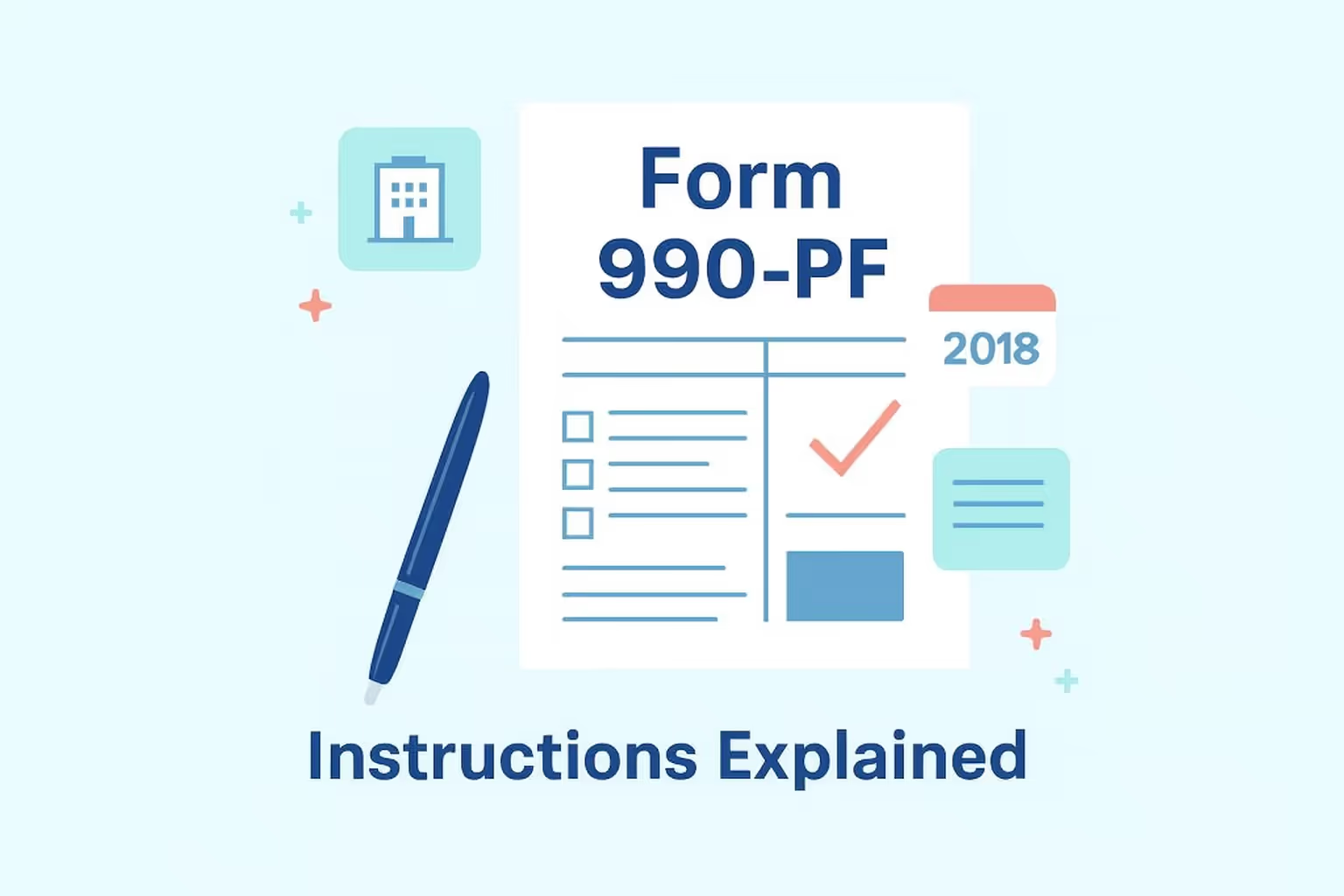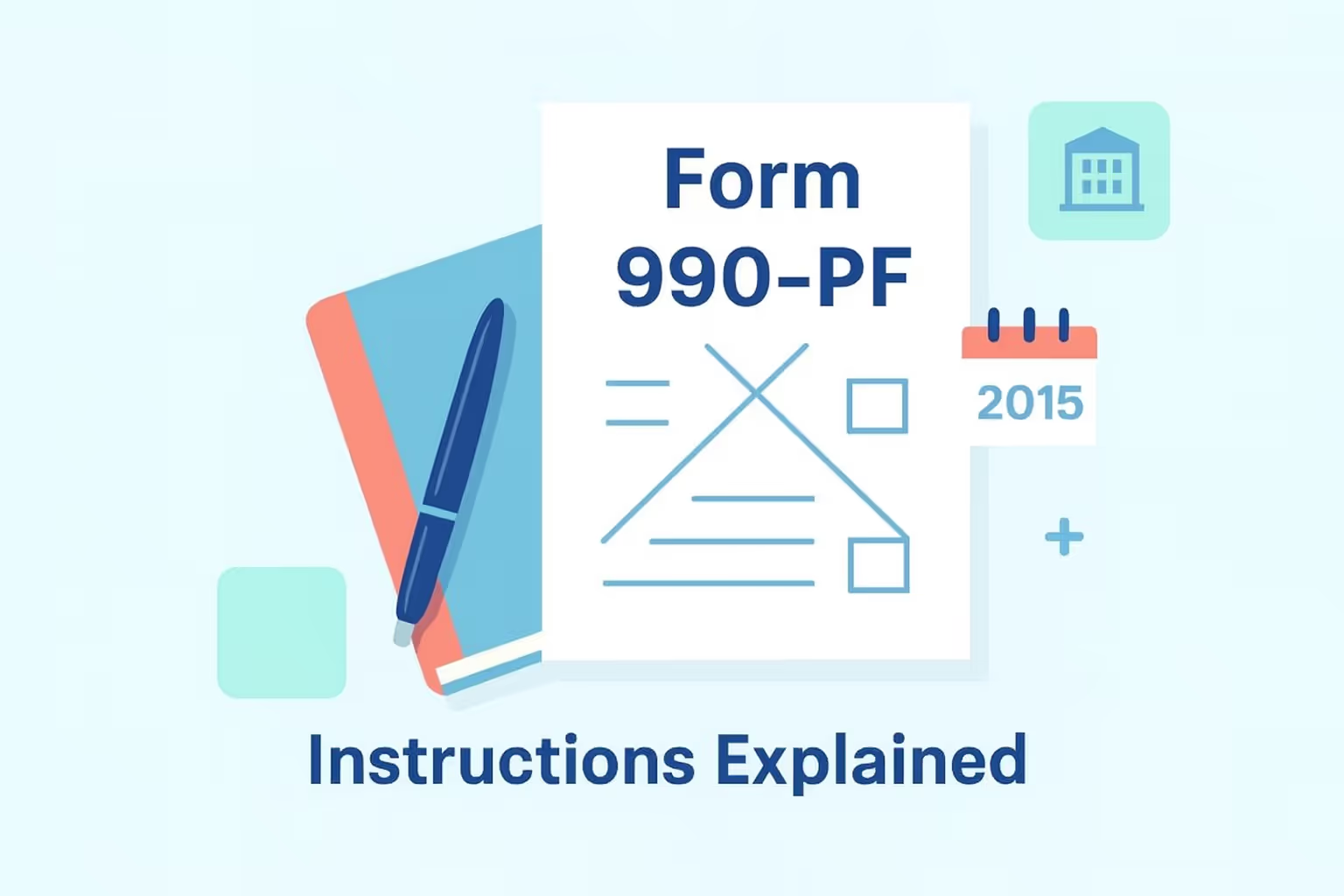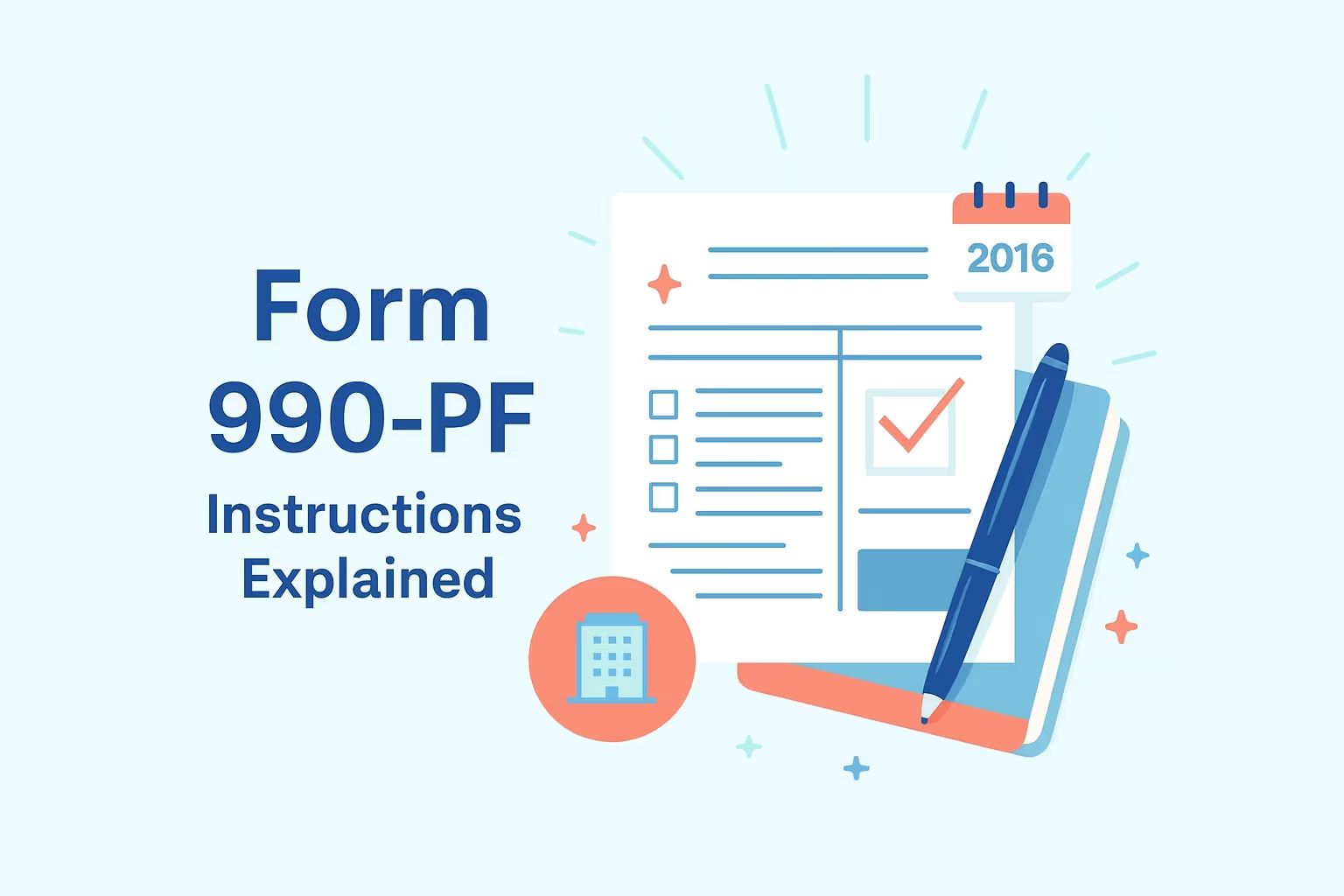Instrucciones del formulario 990-PF 2017: Cómo presentar su declaración de impuestos

Presentar el formulario 990-PF siguiendo las instrucciones de 2017 es un paso necesario para que las fundaciones privadas sigan cumpliendo con los requisitos federales de declaración de impuestos sobre la renta. El formulario proporciona al IRS información detallada sobre la declaración de impuestos federales sobre la renta de una fundación, los ingresos por inversiones y las distribuciones caritativas. También permite a los contribuyentes y al público ver cómo se administran los fondos, lo que contribuye a la transparencia. Muchas organizaciones se sienten abrumadas cuando preparan su declaración de impuestos federales, pero recurren al oficial Instrucciones de 2017 para el formulario 990-PF puede ayudar a reducir el estrés y prevenir errores.
Las fundaciones privadas deben completar esta presentación, independientemente de si operan según un calendario del año calendario o del año fiscal. Para los declarantes del año calendario, la fecha límite es el decimoquinto día del quinto mes, mientras que los declarantes del año fiscal calculan sus fechas límite de manera diferente. Si la fecha límite cae en sábado, domingo o feriado legal, el siguiente día hábil se convierte en la fecha límite oficial. Comprender estos requisitos ayuda al contribuyente a evitar los cargos por intereses, los cargos por pagos atrasados y los reembolsos retrasados. Una preparación cuidadosa garantiza una declaración completa y precisa.
Esta guía proporciona una explicación paso a paso del proceso de presentación. En ella se explica cómo completar cada sección, cómo funcionan los impuestos especiales y cómo enviar los pagos. Con esta información, las personas y las organizaciones pueden disfrutar de una experiencia de presentación más fluida.
Instrucciones y requisitos de presentación del formulario 990-PF 2017
Las fundaciones privadas presentan el formulario 990-PF según las instrucciones de 2017 para cumplir con la ley federal y demostrar transparencia en sus operaciones. El formulario sirve como una declaración de impuestos federales especializada y proporciona informes detallados sobre las obligaciones tributarias, las donaciones caritativas y las actividades de inversión.
Todos los contribuyentes que administran una fundación deben entender qué entidades califican, qué documentos se requieren y cómo se aplican los plazos a los declarantes del año calendario o del año fiscal. Una preparación cuidadosa garantiza que la fundación evite los cargos por intereses, evite demoras en el procesamiento y proteja su condición de entidad exenta de impuestos.
Quién debe presentar el formulario 990-PF
Las organizaciones que deben presentar la declaración incluyen fundaciones privadas exentas, fundaciones privadas sujetas a impuestos y ciertos fideicomisos caritativos no exentos que se consideran fundaciones privadas. Las entidades que esperan el reconocimiento de la exención también deben cumplir con los requisitos si han optado por ser tratadas como una fundación privada.
Un empleador o fideicomisario que presente una solicitud en nombre de una fundación debe asegurarse de que el nombre legal, los números de cuenta y la información de contacto coincidan con los registros del IRS. Si no se presenta a tiempo una declaración de impuestos federales precisa, se corre el riesgo de que la fundación quede exenta. ¿El funcionario Acerca del formulario 990-PF El recurso ofrece acceso directo a los requisitos actuales.
- Fundaciones privadas exentas: Las fundaciones exentas de impuestos deben presentar una declaración anual para cumplir con la ley.
- Fundaciones privadas imponibles: Se requiere presentar el mismo formulario que las organizaciones exentas.
- Fideicomisos caritativos no exentos: Clasificadas como fundaciones privadas según la ley tributaria federal.
- Organizaciones con estatus pendiente: Entidades que eligen la clasificación de fundación privada mientras esperan la exención.
- Empleadores y fideicomisarios: Responsable de presentar una solicitud para una fundación con entradas verificadas.
Requisitos y plazos de presentación
Las obligaciones de presentación van más allá de enviar el formulario en sí. Tanto los declarantes del año calendario como los del año fiscal deben calcular con precisión sus plazos. Para quienes declaran impuestos durante un año calendario, la fecha límite es el decimoquinto día del quinto mes siguiente al final del año calendario.
Los declarantes del año fiscal calculan su fecha de vencimiento en función del cierre de su año fiscal. El siguiente día hábil se convierte en la fecha oficial de presentación cuando la fecha límite cae en sábado, domingo o feriado legal.
- Declarantes del año calendario: La fecha límite vence en mayo del año siguiente.
- Declarantes del año fiscal: La fecha límite vence en el quinto mes siguiente al final del año fiscal.
- Regla legal de feriados o fines de semana: La presentación pasa al siguiente día hábil.
- Presentación electrónica: Obligatorio al presentar 250 o más declaraciones federales.
- Archivado en papel: Permitido para organizaciones más pequeñas si el formulario está firmado y fechado.
El cumplimiento de estos requisitos de presentación garantiza que la fundación cumpla con las obligaciones de declaración de impuestos federales. Comprender tanto la elegibilidad como los plazos ayuda a las organizaciones a evitar costosos contratiempos y contribuye a la precisión de la presentación de informes.
Conceptos básicos sobre la declaración de impuestos federales
Comprender cómo se relaciona la declaración federal de impuestos sobre la renta con las fundaciones privadas es esencial para garantizar la precisión y el cumplimiento al completar las instrucciones del formulario 990-PF para 2017. Si bien este formulario difiere de la declaración típica presentada por individuos o pequeñas empresas, el proceso de presentación de informes tiene varias similitudes. La presentación anual de una fundación debe reflejar la actividad tributaria, los ingresos por inversiones, como dividendos o alquileres, y otros fondos aplicables. El IRS exige a los contribuyentes que presenten información precisa para evitar cargos por intereses o demoras en la presentación de impuestos.
Períodos de presentación y fechas de vencimiento
Las fundaciones privadas deben determinar si declaran en el año calendario o en el año fiscal. Las personas que declaran impuestos durante el año calendario van de enero a diciembre y presentan su declaración federal el decimoquinto día del quinto mes siguiente al final del año.
Los declarantes del año fiscal calculan la fecha límite en función del cierre de su período contable, y la declaración vence el decimoquinto día del cuarto mes después de la fecha de cierre. El siguiente día hábil se convierte en la nueva fecha límite si la fecha de vencimiento coincide con un sábado, domingo o feriado legal. Estas reglas protegen a los contribuyentes de perder los días de presentación y garantizan la imparcialidad en el proceso de presentación.
Responsabilidades de pago e informes
Las responsabilidades de presentación incluyen declarar los impuestos pendientes, identificar los impuestos especiales aplicables y realizar los pagos trimestrales de impuestos estimados, según sea necesario. Incluso si no se adeuda ningún pago, la fundación debe completar su declaración completa. Un contribuyente que adeude dinero debe asegurarse de que el pago se presente junto con la declaración para evitar cargos adicionales.
Cuando se aplican reembolsos, el depósito directo en una cuenta designada brinda un acceso más rápido a los fondos que los cheques en papel. La presentación transparente de informes sobre las cuentas, las ventas de propiedades u otras actividades sujetas a impuestos permite al IRS determinar la precisión y respalda el cumplimiento por parte de la fundación.
Implicaciones de la precisión
La precisión en el proceso de declaración de impuestos federales es fundamental para cada fundación. Declarar dividendos, rentas u otras categorías de ingresos de manera incorrecta puede crear complicaciones que se traduzcan en cargos por intereses o en la prolongación de las revisiones del IRS. Una declaración incompleta, una fecha de vencimiento mal calculada o un pago retrasado pueden generar gastos adicionales o una revisión prolongada.
Completar cada página de la declaración con entradas consistentes garantiza que el contribuyente demuestre el cumplimiento de las leyes tributarias. Las organizaciones que cumplen con los plazos, presentan los archivos adjuntos adecuados y brindan respuestas exhaustivas reducen la probabilidad de demoras en el procesamiento.
La administración adecuada de la declaración de impuestos federales ayuda a las fundaciones privadas a mantener una buena reputación y, al mismo tiempo, cumplir con las obligaciones establecidas en la ley tributaria. Al alinear los períodos de presentación, los pagos y la presentación de informes con las expectativas del IRS, las organizaciones logran un procesamiento más fluido, protegen su estado de exención y mantienen la confianza entre los reguladores y el público.
Proceso de presentación de declaraciones de impuestos federales
El proceso de presentación de declaraciones de impuestos federales para fundaciones privadas requiere una cuidadosa atención a los detalles. Cada fundación debe completar en su totalidad las instrucciones del formulario 990-PF 2017, declarar todas las categorías de impuestos sobre la renta y presentar los archivos adjuntos requeridos.
La precisión en la presentación protege la posición de la fundación, evita que se acumulen intereses sobre los montos impagos y garantiza que los reembolsos no se retrasen. Las fundaciones que presentan sus declaraciones de manera oportuna y precisa demuestran que cumplen con la ley federal de impuestos sobre la renta y, al mismo tiempo, evitan complicaciones administrativas innecesarias.
Pasos de presentación de solicitudes para fundaciones privadas
Cada contribuyente responsable de la declaración de una fundación debe seguir un enfoque estructurado. El proceso incluye preparar la documentación, completar el formulario y enviarlo a través de un canal aprobado.
Dependiendo de la elegibilidad de la fundación, las presentaciones pueden hacerse electrónicamente o archivándolas en papel. La presentación electrónica a menudo proporciona un procesamiento más rápido en comparación con la presentación en papel, mientras que las declaraciones en papel siguen siendo una opción para las organizaciones más pequeñas.
- Reúna registros financieros: Recopile los estados de cuenta, la información sobre las subvenciones y los detalles de la cuenta necesarios para la presentación de informes.
- Complete cada página: Asegúrese de que todos los totales, cifras y cronogramas sean precisos.
- Adjunte documentos justificativos: Incluya cronogramas, explicaciones y cualquier declaración en nombre de los fideicomisarios o funcionarios.
- Firme y feche la devolución: Una firma válida confirma la responsabilidad y la responsabilidad por la exactitud de la declaración.
- Enviar a través del canal adecuado: Presente electrónicamente cuando sea necesario o envíe por correo las declaraciones en papel al centro de servicio designado del IRS.
- Solicitar depósito directo: Cuando es elegible para un reembolso, la selección del depósito directo permite depositar los fondos en la cuenta de la fundación de manera rápida y eficiente.
Cumplimiento y procesamiento
El procesamiento de las declaraciones federales depende de que se completen con precisión y se presenten a tiempo. Las declaraciones incompletas pueden causar demoras significativas, especialmente si faltan los archivos adjuntos requeridos. Las organizaciones que adeudan dinero deben pagar la totalidad al presentar la declaración, mientras que las que esperan un reembolso deben confirmar los detalles de la cuenta bancaria para un procesamiento eficiente.
Si se identifican errores, el IRS puede solicitar interés o solicitar documentación adicional. Un proceso de presentación organizado proporciona cumplimiento y tranquilidad a las fundaciones y sus partes interesadas. El proceso de presentación de solicitudes para las fundaciones privadas demuestra cómo la preparación estructurada mejora los resultados.
Las organizaciones que verifican la exactitud, adjuntan todos los anexos y los presentan a tiempo cumplen con sus responsabilidades como contribuyentes. Al abordar la declaración de impuestos federales con diligencia, las fundaciones privadas salvaguardan su condición de exentas de impuestos, protegen los fondos y establecen su credibilidad mediante el cumplimiento.
Orientación de expertos en impuestos y desafíos comunes
Las fundaciones privadas que completan el formulario 990-PF para 2017 a menudo se enfrentan a situaciones tributarias complejas. Estos desafíos pueden implicar declarar los ingresos por inversiones, cumplir con las obligaciones tributarias especiales o calcular los plazos para presentar las declaraciones de impuestos federales sobre la renta.
Muchas organizaciones se benefician de consultar a un experto en impuestos que comprenda los requisitos específicos de la fundación. Una orientación clara ayuda a los contribuyentes a mantener el cumplimiento, evitar errores y administrar las cuentas de manera más eficaz.
Cuándo buscar apoyo profesional
El apoyo profesional se vuelve valioso cuando los requisitos de presentación de informes van más allá de las presentaciones rutinarias. Un experto en impuestos puede revisar la precisión de los informes de dividendos, confirmar si es necesario realizar pagos de impuestos estimados trimestrales y garantizar el cumplimiento de las normas de distribución. La asistencia especializada también ayuda a las organizaciones a comprender cómo los declarantes del año calendario y los declarantes del año fiscal deben gestionar los diferentes plazos.
- Informes de inversión complejos: Un experto en impuestos garantiza la correcta presentación de informes sobre dividendos, alquileres y ventas de propiedades.
- Cálculos de impuestos especiales: Los profesionales determinan si la fundación reúne los requisitos para la tarifa reducida del uno por ciento.
- Pagos de impuestos estimados trimestrales: Un asesor evalúa si se requieren pagos anticipados.
- Ingresos comerciales no relacionados: Cuando una fundación es propietaria de una pequeña empresa o de una propiedad no relacionada, la revisión de expertos evita la clasificación errónea.
- Demoras en los reembolsos: Un experto en impuestos puede resolver los problemas relacionados con el depósito directo o los errores de cuenta.
- Declaraciones modificadas: Los profesionales ayudan con las correcciones cuando se descubren errores una vez presentada la declaración.
Desafíos comunes que enfrentan las fundaciones
Cada contribuyente que presenta una declaración en nombre de una fundación debe resolver varios problemas recurrentes. La presentación errónea de los fondos, la falta de inclusión de los cronogramas requeridos y los errores al identificar las fechas de vencimiento son comunes. Las organizaciones que operan según los cronogramas del año fiscal a veces calculan mal sus plazos, lo que genera demoras en la presentación de solicitudes. Otras tienen problemas cuando un empleador o un fideicomisario presentan información incompleta en nombre de la fundación.
- Errores de cálculo de la fecha límite: La presentación después del día hábil correcto crea problemas de cumplimiento.
- Faltan archivos adjuntos: La ausencia de cronogramas o explicaciones retrasa el procesamiento del IRS.
- Errores de cuenta: La información incorrecta sobre depósitos directos o reembolsos puede impedir la recepción oportuna de los fondos.
- Entradas de EIN incorrectas: Los errores en los números de identificación del empleador pueden retrasar la aceptación de la solicitud.
- Envíos perdidos: Las fundaciones a veces no confirman la recepción de las devoluciones enviadas por correo.
- Informes de subvenciones incompletos: La falta de detalles en los cronogramas requeridos puede resultar en una revisión adicional por parte del IRS.
Los expertos en impuestos brindan claridad cuando las organizaciones luchan contra estos desafíos. La orientación profesional reduce el riesgo de cometer errores costosos, garantiza la presentación adecuada de informes y refuerza el cumplimiento de los requisitos federales. Al reconocer cuándo el apoyo de expertos es beneficioso, las fundaciones privadas protegen su condición de exentas y mejoran la precisión de sus declaraciones.
Declarantes del año calendario frente a declarantes del año fiscal
Las fundaciones privadas deben entender cómo se determina su cronograma de presentación de impuestos, ya que los plazos dependen de si presentan declaraciones en el año calendario o en el año fiscal. Identificar correctamente el estado de la declaración de impuestos ayuda a los contribuyentes a calcular su fecha límite, preparar los documentos a tiempo y presentar su declaración de impuestos federales sin demoras. Ambos cronogramas tienen requisitos distintos, y las reglas de presentación se aplican por igual a las organizaciones pequeñas y grandes.
Explicación de los horarios de presentación
Los declarantes del año calendario operan según el período de informe estándar de enero a diciembre. Las instrucciones para presentar el formulario 990-PF de 2017 requieren que se presenten antes del decimoquinto día del quinto mes siguiente al final del año, lo que normalmente significa el 15 de mayo. Los declarantes del año fiscal siguen cualquier período contable de doce meses que no termine el 31 de diciembre.
Su fecha límite también cae el decimoquinto día del quinto mes siguiente al final del año fiscal. El siguiente día hábil se convierte en la fecha límite oficial si la fecha límite es un sábado, domingo o feriado legal. El IRS proporciona recursos para organizaciones sin fines de lucro a través de su Organizaciones benéficas y sin fines de lucro sección.
Tabla de reglas de presentación
Declarantes del año calendario
- Período cubierto: Del 1 de enero al 31 de diciembre
- Fecha límite de devolución: 15 de mayo (quinto mes después de fin de año)
- Ajustes de fecha límite: Si el 15 de mayo cae en fin de semana o feriado legal, la fecha límite pasa al siguiente día hábil.
- Ejemplo: La declaración de 2017 debía presentarse el 15 de mayo de 2018.
- Impacto: Los contribuyentes deben planificar sus presentaciones en torno a las fechas límite de primavera.
Declarantes del año fiscal
- Período cubierto: Cualquier ciclo de 12 meses que no termine el 31 de diciembre
- Fecha límite de devolución: Decimoquinto día del quinto mes después del cierre del año fiscal
- Ajustes de fecha límite: Se aplica la misma regla: si la fecha de vencimiento cae en fin de semana o feriado, pasa al siguiente día hábil.
- Ejemplo: La declaración correspondiente al año fiscal que termina el 30 de junio vence el 15 de noviembre.
- Impacto: Los contribuyentes deben calcular los plazos de presentación en función de su período contable único.
Consideraciones clave para ambos cronogramas
Las fundaciones también deben considerar la posibilidad de presentar prórrogas, pagos de impuestos estimados y obligaciones de impuestos especiales, independientemente del cronograma. Las personas que declaran impuestos tanto en el año calendario como en el año fiscal pueden solicitar más tiempo para presentar la declaración; sin embargo, cualquier monto pendiente debe pagarse antes de la fecha límite original para evitar intereses.
Los contribuyentes también deben verificar la información de su cuenta si esperan recibir un reembolso mediante depósito directo, ya que las entradas incorrectas pueden retrasar el procesamiento. Las organizaciones que realizan pagos trimestrales de impuestos estimados deben alinearlos con el año fiscal o período contable que hayan elegido.
Mantener la claridad en los cronogramas de presentación ayuda a las organizaciones a evitar el incumplimiento de los plazos y garantiza que cumplan con sus obligaciones de declaración de impuestos federales. Las personas que declaran durante el año calendario se benefician de un cronograma predecible, mientras que las que declaran en el año fiscal obtienen flexibilidad para alinear las declaraciones con las operaciones financieras.
Ambos enfoques requieren una planificación precisa, atención a las fechas de entrega y finalización cuidadosa de cada página. Al comprender estos requisitos, las fundaciones privadas refuerzan el cumplimiento, protegen su estado de exención y demuestran su responsabilidad en sus informes financieros.
La forma más rápida de presentar y enviar pagos
Las fundaciones privadas que presentan las instrucciones del formulario 990-PF de 2017 pueden ahorrar tiempo y reducir las demoras en el procesamiento al seguir métodos comprobados de presentación y pago. El IRS acepta presentaciones electrónicas y en papel; sin embargo, la presentación electrónica brinda una mayor eficiencia a los contribuyentes, particularmente a aquellos que deben presentar varias declaraciones federales. La elección del método correcto también afecta la rapidez con la que una organización recibe la confirmación, evita los cargos por intereses y garantiza los reembolsos mediante el depósito directo.
Pasos para la presentación y el pago
- Determine la elegibilidad para la presentación electrónica
Las fundaciones deben revisar si están obligadas a presentar declaraciones electrónicamente o si se les permite presentar declaraciones en papel. Las organizaciones más pequeñas aún pueden presentar sus solicitudes electrónicamente de forma voluntaria para garantizar un procesamiento más rápido. - Prepare la documentación completa
Reúna todos los registros financieros, los estados de inversión y los detalles de la subvención antes de comenzar el proceso de presentación. Revise cada página de la declaración federal de impuestos sobre la renta para asegurarse de que sea precisa antes de presentarla. - Presente el formulario electrónicamente.
Use un software aprobado por el IRS o un profesional de impuestos autorizado para transmitir la declaración. La presentación electrónica proporciona un acuse de recibo, lo que reduce el riesgo de perder las presentaciones. - Envíe las devoluciones en papel solo si está permitido.
Si presenta la declaración en papel, use la dirección correcta del centro de servicio del IRS e incluya todos los archivos adjuntos requeridos. Siempre firme y feche la declaración para confirmar la responsabilidad. - Selecciona depósito directo para los reembolsos.
Solicitar el depósito directo permite que los reembolsos se depositen en la cuenta de la fundación más rápidamente que con cheques de papel. - Realice el pago de impuestos requerido.
Envíe los pagos de impuestos especiales o impuestos sobre la renta mediante el Sistema electrónico de pago de impuestos federales (EFTPS) u otros métodos aprobados. Los pagos deben recibirse antes de la fecha de vencimiento original, incluso si se ha otorgado una prórroga para presentar la solicitud. - Rastrea el estado del acuse de recibo y pago
Verifique que el IRS haya aceptado la declaración y aplicado el pago correctamente. El monitoreo de los registros de las cuentas garantiza que los reembolsos, los créditos o los cargos por intereses se reflejen con precisión.
Eficiencia y cumplimiento
La presentación rápida y la selección del método más rápido mejoran tanto el cumplimiento como la eficiencia operativa. La presentación electrónica combinada con el depósito directo ofrece la mayor garantía de un procesamiento oportuno, mientras que el EFTPS protege la precisión de los pagos de impuestos. Al seguir pasos estructurados y verificar cada entrada en la cuenta, las fundaciones privadas demuestran su responsabilidad y minimizan el riesgo de demoras o evaluaciones de intereses. El cumplimiento cuidadoso de estos procesos refuerza el cumplimiento y respalda la misión continua de la organización.
Cronogramas, anexos y ejemplos requeridos
Las fundaciones privadas deben incluir los anexos y anexos requeridos al completar el formulario 990-PF para el año tributario 2017, según las instrucciones del IRS. Estos documentos proporcionan información de respaldo sobre las subvenciones, los ingresos por inversiones y otros elementos de la declaración de impuestos federales.
Un contribuyente que no presente los archivos adjuntos adecuados puede experimentar demoras en el procesamiento, correspondencia adicional o solicitudes rechazadas. La preparación organizada garantiza que todos los ejemplos, cronogramas y declaraciones de respaldo estén listos antes de su presentación.
Siempre obligatorio
- Detalles de la subvención de la Parte XV: Este cuadro proporciona una lista completa de todas las contribuciones, los destinatarios, los montos y los propósitos del año.
- Anexos del balance: Estos anexos incluyen documentación que respalda partidas importantes de activos o pasivos.
- Cronogramas de ingresos y gastos: Estos anexos proporcionan un desglose detallado de la actividad de la cuenta a partir de la declaración federal de impuestos sobre la renta.
- Información del fideicomisario o funcionario: En esta sección se enumeran los nombres, funciones y registros de servicio de las personas que administran la fundación.
Requerido condicionalmente
- Programa B: Este cronograma es obligatorio cuando una fundación recibe 5.000 dólares o más en contribuciones de un solo donante en un solo año.
- Cronogramas de inversión: Estas listas son necesarias para informar sobre las acciones corporativas, las obligaciones gubernamentales u otros valores.
- Cronogramas de ganancias de capital: Deben prepararse cuando una organización vende propiedades u otros activos importantes.
- Declaraciones de actividades internacionales: Estos anexos son obligatorios cuando las distribuciones o actividades involucran cuentas o entidades extranjeras.
Requisitos de formato
- Identificación: Cada adjunto debe incluir el nombre de la fundación, el número de identificación del empleador y el año tributario.
- Etiquetado: Cada programa debe especificar el número de pieza o línea que admite.
- Coherencia: La información debe coincidir con las cifras proporcionadas en las secciones principales de la declaración.
- Secuenciación: Los cronogramas deben seguir el orden del formulario para facilitar una revisión simplificada.
- Claridad: Todos los archivos adjuntos deben ser legibles, estar claramente etiquetados y estar completos.
Ejemplos prácticos
- Informes de subvenciones: La fundación que otorga becas debe incluir los nombres de las escuelas, los montos desembolsados y los fines para los que se utilizan los fondos.
- Ingresos por inversiones: Al declarar dividendos, la fundación debe adjuntar los estados de cuenta de los corredores o bancos.
- Ventas de propiedades: Los cronogramas complementarios deben incluir descripciones, fechas e importes obtenidos de cada venta.
- Subvenciones extranjeras: Adjunte informes detallados que describan la actividad e identifiquen a los destinatarios extranjeros.
La presentación de anexos y anexos completos garantiza que la declaración de impuestos federales sea precisa y esté debidamente documentada. Los informes organizados respaldan el cumplimiento, fortalecen la rendición de cuentas y demuestran que la fundación cumple con sus obligaciones de manera responsable.
Preguntas frecuentes
¿Cuál es el propósito de presentar el modelo 990 para las instrucciones de 2017?
El formulario 990-PF proporciona al IRS información detallada sobre la declaración de impuestos federales sobre la renta de una fundación, las ganancias por inversiones y las distribuciones caritativas. Al completar la declaración, el contribuyente demuestra que cumple con las normas del impuesto sobre la renta y garantiza la transparencia en la administración de los fondos. La presentación también ayuda a proteger la exención de impuestos de una fundación y demuestra que las distribuciones apoyan las actividades caritativas aprobadas durante el año calendario o el año fiscal.
¿Cómo determinan los plazos los declarantes del año calendario y los declarantes del año fiscal?
Los contribuyentes del año calendario reportan la actividad de enero a diciembre y deben presentar su declaración de impuestos federales antes del 15 de mayo. Los declarantes del año fiscal utilizan cualquier ciclo de doce meses que no termine el 31 de diciembre y presentan su declaración el decimoquinto día del quinto mes después del cierre. Si la fecha límite coincide con un sábado, un domingo o un feriado legal, la declaración debe presentarse el siguiente día hábil.
¿Se requieren pagos trimestrales de impuestos estimados para las fundaciones privadas?
Sí, es posible que se requieran pagos de impuestos estimados trimestrales si los ingresos por inversiones generan una obligación tributaria significativa. Los pagos ayudan al contribuyente a evitar adeudar un saldo elevado al presentar el formulario 990 para el año tributario 2017. La presentación puntual de los pagos reduce el riesgo de incurrir en intereses adicionales. Ya sea que presenten declaraciones para el año calendario o para el año fiscal, las organizaciones deben hacer un seguimiento cuidadoso de sus obligaciones tributarias y alinear los pagos con su cronograma contable.
¿Qué ingresos deben declararse en la declaración de impuestos federales?
Las fundaciones privadas deben declarar dividendos, alquileres, ganancias de capital por la venta de propiedades y otros ingresos imponibles. Todos los montos se registran en la declaración federal de impuestos sobre la renta, ya sea que se hayan ganado durante un año calendario o un año fiscal. La declaración completa de los ingresos permite al IRS determinar los impuestos especiales y verificar que las distribuciones cumplan con los requisitos mínimos. Las entradas faltantes o incorrectas pueden retrasar los reembolsos o requerir una revisión adicional.
¿Cómo puede una fundación recibir un reembolso rápidamente?
La forma más rápida para que un contribuyente reciba un reembolso es solicitar un depósito directo en la cuenta de la fundación. Esta opción procesa los reembolsos más rápido que los cheques en papel. Los reembolsos pueden producirse cuando los pagos trimestrales de impuestos estimados o los sobrepagos de impuestos especiales superan el pasivo final. Garantizar la precisión de los detalles de la cuenta evita demoras. Ya sea que presente una declaración en el año calendario o en el año fiscal, el depósito directo es el método de entrega más confiable.
¿Qué sucede si la declaración se presenta con retraso?
Una fundación que no presente su declaración de impuestos federales antes de la fecha de vencimiento requerida puede adeudar intereses y cargos adicionales. Tanto las personas que declaran en el año calendario como las que declaran en el año fiscal se enfrentan a consecuencias si su declaración no está completa. Presentar el formulario 990 para 2017 a tiempo protege la condición de exenta de la organización y garantiza que la organización pueda continuar sus operaciones. Las prórrogas pueden dar más tiempo, pero aun así los pagos deben hacerse con prontitud.
¿Por qué es fundamental el mantenimiento de registros para las fundaciones privadas?
El mantenimiento de registros precisos garantiza que los informes de impuestos sobre la renta, las subvenciones y los cronogramas se alineen con la declaración federal completa. Las fundaciones deben hacer un seguimiento de las cuentas, los estados de inversión y las resoluciones de la junta para respaldar las instrucciones del formulario 990 para 2017. La documentación organizada permite a los contribuyentes verificar los pagos de impuestos estimados trimestrales, demostrar el cumplimiento y reducir la probabilidad de errores. Los registros confiables también respaldan la transparencia, protegen la exención y ayudan a las organizaciones a rendir cuentas por las distribuciones caritativas de cada año.



























